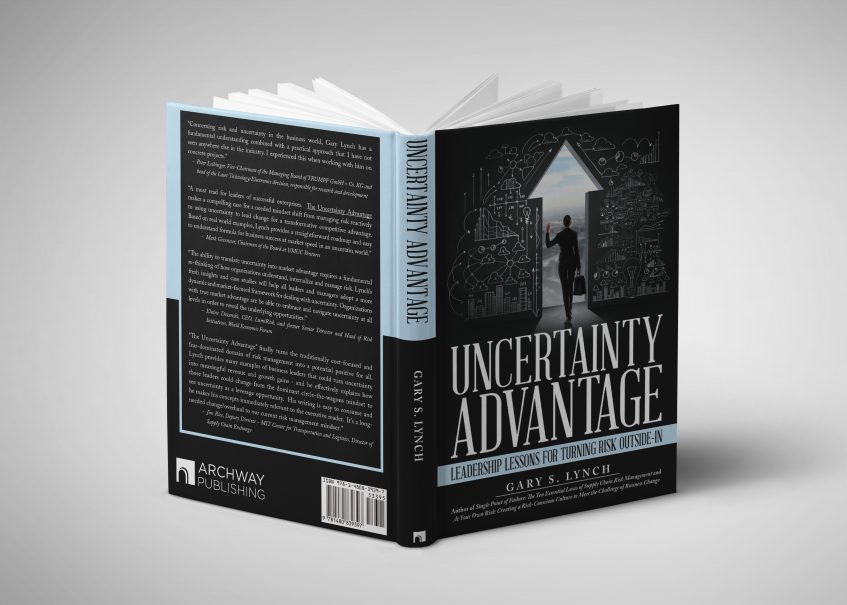-
16
Feb
Is “Value Analysis” the Correct Risk Measurement?
A few weeks have passed since the release of my new book, “Uncertainty Advantage: Leadership Lessons for Turning Risk Outside-In.” Now begins the journey of raising awareness of a true market-driven strategy, not as much for risk management as for uncertainty navigation.
Addressing these topics are an upcoming article and presentation: Next week an article in strategy+business will be released (strategy-business.com) and on March 1st, I will be keynoting the Global Supply Chain Resiliency Council meeting in Milpitas California (bit.ly/2kum3Ce).
I’d like to begin the journey by challenging a prevailing risk assumption: Is value the correct risk measurement?
Value, after all, is highly personal and subjective, often biased and representing a measure not of current, but of past performance. Growth, on the other hand, is a forward looking, tangible, market-based metric.
- Growth is defined by the market, an Outside In perspective
- Value is typically defined by the individual (parts rather than whole) and represents the organization’s Inside Out perspective
For those who study risk and economics, the question has roots all the way back to 1921 and the work of Chicago Economist Frank Knight’s dissertation on Risk, Uncertainty and Profit. Knight suggested that whenever you are faced with uncertainty, turn it to risk. This implies that we can know or assign probabilities to the possible outcomes of uncertain information and use it to make decisions for profit. Charles Sanford, the chairman of Banker’s Trust chairman in the 1980s and 1990s and a well-known innovator in using risk as a strategic tool, famously built up the derivative trading business based in part of the principle that “The only reason to take risk is to earn a return.”The reality is that risk management hadn’t changed much over the past few decades and most of what is done today in the areas of enterprise risk management (ERM) within the insurance industry is based on “value” and the asset. But as I learned from many great leaders, what matters most is that (financial) performance and value matter, but not as much as tomorrow’s prospects for growth. This is a profound adjustment to risk-based thinking. It may be why investor inquiries tend to favor more the topic of guidance, prospects, and forward looking comments, and less for reflection, defense, and risk reduction (which also translates to profit reduction).
I saw an opportunity to leverage uncertainty (mindset, capabilities and competencies) and convert it into a competitive weapon. I believe that there is an untapped opportunity to get greater value or return from risk investments, having spent most my career helping organizations manage risk, build resiliency capabilities and protect value. An increasing number of leaders have recognized that a better understanding (and resolution of) uncertainty leads to a greater market differentiation with investors, strategic partners, those underwriting risks, regulators, and special interest groups. This enables the leader to make decisions faster, take on more risk for greater potential reward as well as use knowledge, understand capabilities, and tap into competencies to differentiate the risk from the opportunity.
My recently released book contains more than 20 growth-related cases of leaders who used uncertainty for market advantage; five leadership principles for navigating uncertainty; a transformation agenda; a description of the actors and an explanation of the reconciliation process amongst them; and examples of their skillfully applied mindsets, competencies and capabilities. It is not a book on theory, but rather a practical field guide. Some examples:
- Better, faster and more precise business decisions. By better understanding and reacting to uncertainty in a time of market chaos, the CEO of a major auto manufacturer was able to transform market uncertainty into a buying force. This resulted in a 9% increase in annual sales compared to a 20-40% drop for six of the other major manufacturers.
- Greater insight for more strategic decision making. By better understanding uncertainty, the Head of Research and Portfolio manager at a major hedge fund was able to uncover investment opportunities that yielded significUnUant returns on behalf of the client (market).
- A new revenue stream. By better understanding uncertainty of global product and supply chains, underwriters were willing to create new products to finance non-physical damage risk such as port strikes, nationalism, and pandemics.
- More efficient allocation of capital. By better understanding uncertainty, the CEO of a European precision manufacturer quickly prioritized which risk investments would have the greatest return, in terms of the markets and customers.
To find out more, please contact me at gary.lynch@theriskproject.com
To order the book, please visit: archwaypublishing.com
